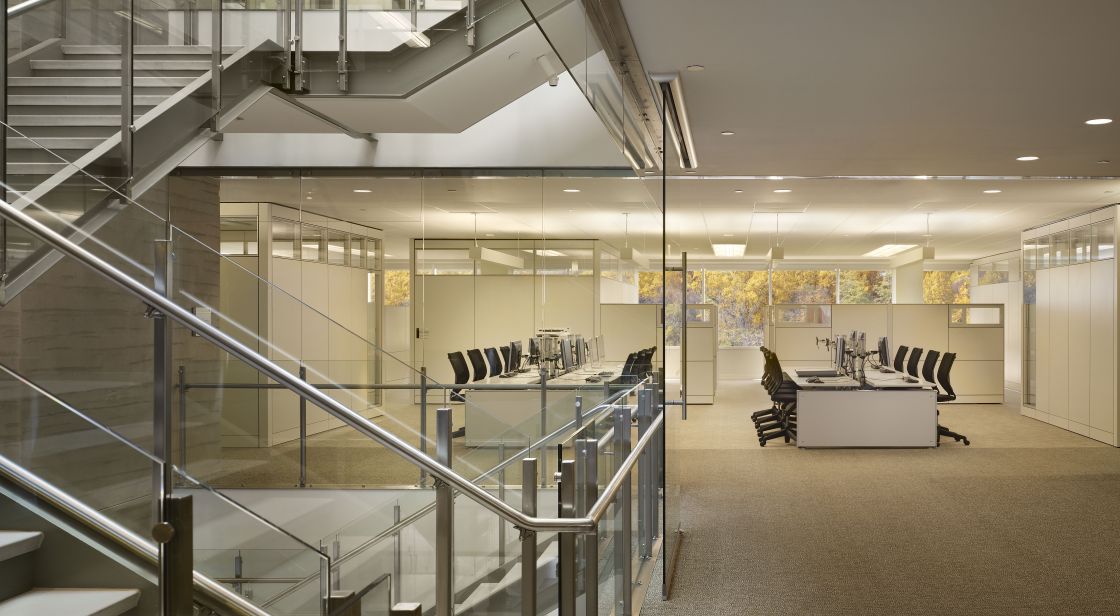To manage change of place successfully, great time and effort is invested to fully understand organizational and individual needs—from work process to office preferences. This holistic approach results in a built workplace that not only pleases its inhabitants, but spurs creativity, productivity and enriches the overall quality of work life as it supports the organization’s mission.
701 Carnegie is the address of Princeton University’s first off-campus administration building, housing seven previously dispersed Information Technology departments and the Office of the Treasurer. A relocation that was once a dramatic change and cause for end user anxiety has now become the cause of “701 Envy” for the remaining administration functions on campus. Working hand-in-hand, the ease of transition to the new building and the success of its design can be credited to both in-depth Workplace Strategy and extensive Culture Enhancement.
Workplace Strategy: Collaboration—understanding that open communication and true partnership through the process facilitates change.
Extensive change management exercises were conducted to solicit employee buy-in, promote a sense of ownership and ease the transition to the new space. KSS worked with department teams to understand the nuances of work process and preferences. KSS also hosted Town Hall Meetings to listen and learn, and created numerous mock-ups to aid in the visualization of the new space. Overwhelmingly, inquiry revealed that daylight became the most important element in the new building, ultimately affecting the building’s workplace layout in order to maximize daylight and views.
Workplace Strategy: Inspiration—discovering key elements that converge to create a dynamic, thriving workplace.
So significant was the call for daylight that KSS proposed a central core of offices, encircled by workstations, windows, and exterior views. Glass elements were incorporated into the workstations to increase the sense of transparency. A “sacred zone” of daylight, and its daily movement, was established, prohibiting the intrusion of any other element in that zone. The light became the common, connecting factor of the building. The central staircase became an additional beacon of light and connection, both literally and figuratively—a place to see and be seen. The width of the stairs and depth of the landings promote impromptu interaction and collaboration, with easy access to coffee and break areas. By intention and through design, the light of the central staircase transcends the building: vertically, horizontally, and effusively.
Culture Enhancement: Identity—creating a sense of place and a physical, emotional connection to the organization.
Although physically off-campus, 701 Carnegie provides a visual reference to the campus. The Princeton University brand is extended by utilizing established color pallets and similar materials of wood and stone. KSS also worked with a University Archivist to locate photographic images of architectural elements of the campus. These images were screened onto glass panels installed within the office to complete the visual connection to campus. To further foster a sense of inclusion in campus life, a conference center was incorporated into the programming to draw additional University departments to visit and use the new space.
Culture Enhancement: Affinity—fostering a tangible sense of team and belonging.
Through the intricate process of planning, designing, and building a new home, daylight revealed the vital connections between the technology teams and within the Treasury office that had been overshadowed by their previously incongruent workspaces. Inter and intra-departments reveled in their increased ability to catch up and collaborate, both professionally and socially—and to become a unified entity. Over the length of the project, feelings of ownership transferred from the old buildings to the new, generating pride and purpose amid the new inhabitants and producing “701 Envy” among University counter-parts. By forging partnerships based on intensive listening, learning and dialogue, KSS successfully brought about change by building trust.

